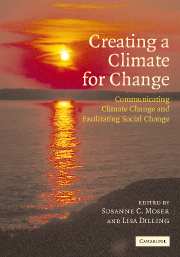Book contents
- Frontmatter
- Contents
- Preface
- Foreword
- List of contributors
- List of tables
- List of figures
- List of text boxes
- Introduction
- Part I Communicating climate change
- Part II Facilitating social change
- 15 Stuck in the slow lane of behavior change? A not-so-superhuman perspective on getting out of our cars
- 16 Consumption behavior and narratives about the good life
- 17 Educating for “intelligent environmental action” in an age of global warming
- 18 Education for global responsibility
- 19 Changing the world one household at a time: Portland's 30-day program to lose 5,000 pounds
- 20 Changing organizational ethics and practices toward climate and environment
- 21 Change in the marketplace: business leadership and communication
- 22 The market as messenger: sending the right signals
- 23 Making it easy: establishing energy efficiency and renewable energy as routine best practice
- 24 Forming networks, enabling leaders, financing action: the Cities for Climate Protection™ campaign
- 25 Ending the piecemeal approach: Santa Monica's comprehensive plan for sustainability
- 26 States leading the way on climate change action: the view from the Northeast
- 27 West Coast Governors' Global Warming Initiative: using regional partnerships to coordinate climate action
- 28 Building social movements
- 29 Climate litigation: shaping public policy and stimulating debate
- 30 The moral and political challenges of climate change
- Part III Creating a climate for change
- About the authors
- Index
- References
21 - Change in the marketplace: business leadership and communication
Published online by Cambridge University Press: 20 August 2009
- Frontmatter
- Contents
- Preface
- Foreword
- List of contributors
- List of tables
- List of figures
- List of text boxes
- Introduction
- Part I Communicating climate change
- Part II Facilitating social change
- 15 Stuck in the slow lane of behavior change? A not-so-superhuman perspective on getting out of our cars
- 16 Consumption behavior and narratives about the good life
- 17 Educating for “intelligent environmental action” in an age of global warming
- 18 Education for global responsibility
- 19 Changing the world one household at a time: Portland's 30-day program to lose 5,000 pounds
- 20 Changing organizational ethics and practices toward climate and environment
- 21 Change in the marketplace: business leadership and communication
- 22 The market as messenger: sending the right signals
- 23 Making it easy: establishing energy efficiency and renewable energy as routine best practice
- 24 Forming networks, enabling leaders, financing action: the Cities for Climate Protection™ campaign
- 25 Ending the piecemeal approach: Santa Monica's comprehensive plan for sustainability
- 26 States leading the way on climate change action: the view from the Northeast
- 27 West Coast Governors' Global Warming Initiative: using regional partnerships to coordinate climate action
- 28 Building social movements
- 29 Climate litigation: shaping public policy and stimulating debate
- 30 The moral and political challenges of climate change
- Part III Creating a climate for change
- About the authors
- Index
- References
Summary
In recent years, there has been a shift in the way companies are thinking about climate change and the policies needed to curb it. This change has been heralded by the popular press – including a cover story in Business Week in August 2004 entitled “Climate Change – Why Business is Taking it Seriously” (Carey and Shapiro, 2004). Climate change has also been featured in recent issues of Fortune (Stipp, 2003) and The Economist (2004). In addition, the influential Conference Board recently issued a statement emphasizing the need for firms to evaluate their contribution to the problem, and a number of shareholder resolutions and lawsuits are driving companies to examine and explain their strategies and plans for conducting business in a carbon-constrained world (Bennett, 2004; Leahy et al., 2004; Carlton et al., 2004; see also Atcheson, Chapter 22, this volume).
This shift did not happen overnight. In the years leading up to negotiation of the Kyoto Protocol, a large number of companies participated in a vocal industry group called the Global Climate Coalition (GCC). This coalition opposed any binding restrictions on GHG emissions, questioning the scientific basis for concerns about human-induced climate change and arguing that climate policy would be costly and result in job losses (see McCright, Chapter 12, this volume).
Although the GCC helped to polarize the climate change debate, it was not necessarily representative of the entire business community's perspective on climate change (Climate Change Task Force, 1997).
- Type
- Chapter
- Information
- Creating a Climate for ChangeCommunicating Climate Change and Facilitating Social Change, pp. 319 - 338Publisher: Cambridge University PressPrint publication year: 2007
References
- 2
- Cited by



